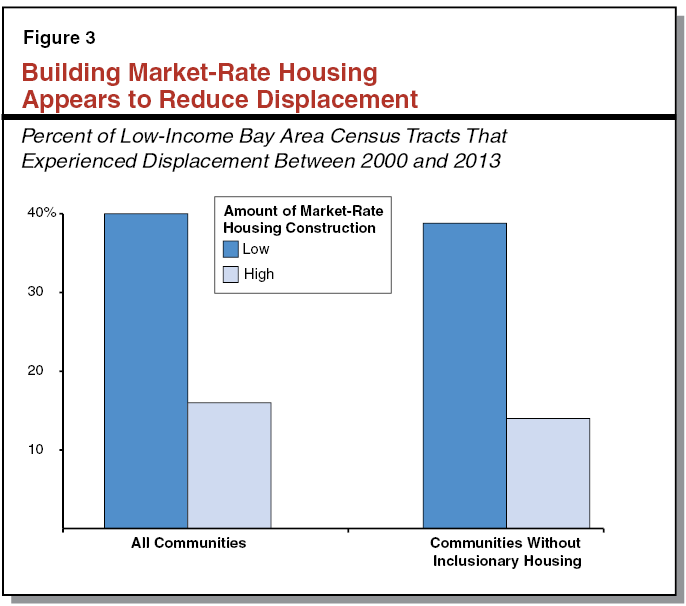 As housing growth in big cities fails to keep up with job growth, the inevitable surge in home prices and rents creates a squeeze on middle income earners. But it also pushes many of these individuals out to low-cost sprawl areas, whether it’s the San Joaquin Valley by the Bay Area or high desert or Inland Empire by Los Angeles.
As housing growth in big cities fails to keep up with job growth, the inevitable surge in home prices and rents creates a squeeze on middle income earners. But it also pushes many of these individuals out to low-cost sprawl areas, whether it’s the San Joaquin Valley by the Bay Area or high desert or Inland Empire by Los Angeles.
The consequence of that migration is not just a major environmental toll, as these individuals commute long distances to job centers while sprawling out over open space and agricultural lands. It’s also further economic inequality. As California’s Legislative Analyst’s Office (LAO) reports:
This data suggests [sic] that those who work in relatively inexpensive inland California have a harder time making ends meet than those working in high cost coastal areas. It further suggests that many workers are made worse off by moving away from high-wage places like the Bay Area. Why then do households (especially low-income households) appear to be leaving high-wage coastal areas? Based on the research discussed above and our office’s prior work, it seems likely that a major contributing factor is their inability to find housing.
Restrictive housing policies in high-wage areas therefore push people into poor areas of the state, where they remain poor as they lack access to good jobs.
It’s not a recipe for a healthy, functioning society in the long term.
It’s the trickiest issue for infill-boosters: how to make sure new development doesn’t displace existing residents, particularly low-income renters or owners? Gentrification is the big concern.
But a new report from the Legislative Analyst’s Office (LAO) suggests that cities that build more market-rate housing in general may suffer less displacement:
Encouraging additional private housing construction can help the many low–income Californians who do not receive assistance. Considerable evidence suggests that construction of market–rate housing reduces housing costs for low–income households and, consequently, helps to mitigate displacement in many cases. Bringing about more private home building, however, would be no easy task, requiring state and local policy makers to confront very challenging issues and taking many years to come to fruition. Despite these difficulties, these efforts could provide significant widespread benefits: lower housing costs for millions of Californians.
This trend holds true even without inclusionary housing policies that require new developments to subsidize affordable housing:
 The bottom line seems to be that the more market-rate housing, the more overall prices stabilize, which in turn allows existing residents to be able to continue to afford to stay in their homes. It also provides new housing opportunities for middle- and high-income residents, so they don’t gentrify and push out lower-income neighbors.
The bottom line seems to be that the more market-rate housing, the more overall prices stabilize, which in turn allows existing residents to be able to continue to afford to stay in their homes. It also provides new housing opportunities for middle- and high-income residents, so they don’t gentrify and push out lower-income neighbors.
The report authors provide a helpful video to summarize the findings:
The headlines this morning from the Bay Area are not looking good, if you’re concerned about California’s woeful lack of housing production, particularly in the coastal metropolitan areas. As I’ve written before, the historic underproduction has led to insane housing and rental prices, extreme gentrification, outlying sprawl, and terrible traffic and air quality problems.
Yet in response to the challenge, we’re seeing more of the same activists attempting to shut down or stunt housing development in the inner core — exactly where we need new housing. First, San Francisco’s board of supervisors narrowly shot down a proposal to put a moratorium on new housing in the Mission District. It’s now likely to go to the ballot. Second, activists shut down an Oakland City Council meeting on a proposed 24-story residential tower. And finally, San Francisco supervisor Jane Kim wants to go to the ballot to shut down the San Francisco Giants mixed-use project next to their ballpark.
All this on the heels of restrictive zoning and ballot challenges that we’ve seen up and down the state, particularly in places like Santa Monica and San Francisco. If local government leaders continue to defer to these opponents, our present environmental and economic challenges will only worsen.
Okay, I’m no expert on three-minute videos on California land use. But of the ones I’ve seen, none are more urgent or more succinct about California’s housing and rental crunch than this one from the California Legislative Analyst’s Office, describing their new report:
And here’s my take on the report. I’m glad the LAO is trying to get the word out about their findings via video like this.
We must continue to shine a spotlight on restrictive coastal housing policies in California. Or else the state’s problems — inequality, sprawl, long commutes, air pollution, squeezed household budgets — will only get worse.
Count me as a supply-sider. Not when it comes to Reaganomics, where supply-side economics has reliably led to deficits and inequality. No, I’m talking about addressing California’s insanely high housing costs. These high costs are squeezing the middle class and businesses alike, creating economic inequality and environmental ruin as residents move to far-flung housing over open space and agricultural land with long commutes.
As a supply-sider, I believe we can address this crisis by increasing housing supply, particularly in coastal areas. And now the nonpartisan California Legislative Analyst’s Office (LAO) has comprehensively documented how this lack of housing supply as led to corresponding price increases in a new report. The report compares California’s housing prices to the nationwide average, and the trends are bad:
Beginning in about 1970, however, home prices throughout the state began to accelerate. Prices were 80 percent above U.S. levels by 1980, and by 2010, the typical California home was twice as expensive as the typical U.S. home. As of 2015, average California home prices were two–and–a–half times higher than average national home prices.
It’s even worse in our coastal metropolitan areas, such as San Francisco, Los Angeles, and San Diego. Compared to other metropolitan areas, coastal California cities haven’t built housing like they should have:
For example, Seattle—a coastal metro with economic characteristics and average temperatures that are similar to California’s Bay Area metros—added new housing units at about twice the rate as San Francisco and San Jose over the last two decades. (Specifically, Seattle’s housing stock—its total number of housing units—grew at an average annual rate of 1.4 percent per year while San Francisco and San Jose’s housing stock grew by only 0.7 percent per year.)
Per Economics 101 and overwhelming statistical analysis, the LAO firmly attributes the price rise to the lack of supply:
Our review indicates that that the relationship between growth of housing supply and increased housing costs is complex and affected by other factors—such as demographics, local economies, and weather. Nonetheless, using common statistical techniques to account for the influence of these other factors, there remains a strong relationship between home building and prices. For example, our analysis suggests that—after controlling for other factors—if a county with a home building rate in the bottom fifth of all counties during the 2000s had instead been among the top fifth, its median home price in 2010 would have been roughly 25 percent lower. Similarly, its median rent would have been roughly 10 percent lower.
It’s worth noting that some local housing activists dispute this causal link. They claim that the problem isn’t with supply but with other factors like income levels. San Francisco Supervisor Jane Kim even tweeted a link to this article that claimed to debunk the supply-side argument, although it only analyzed housing production in the City of San Francisco and failed to examine supply issues across the metropolitan region. The LAO (and I) certainly concede that there are multiple factors affecting housing prices, but the lack of supply is certainly — indisputably — a big one.
So what is stopping new supply? The LAO first and foremost points to restrictive local land use policies. Conservatives like to bag on California for all of its supposedly anti-business regulations (although I’d like to note that California has been doing better in the past year than every state, including conservative poster child Texas, in the economic output department). But they always seem to ignore our over-regulated local housing sector.
Local governments in California’s coastal areas have steadfastly refused to allow enough housing production. They make it illegal under zoning codes; they approve retail projects over housing to chase sales tax dollars; their residents threaten ballot initiatives over new housing projects; and neighborhood groups sue housing developers under the California Environmental Quality Act (CEQA).
The state is rife with examples. Santa Monica residents get their pitchforks out over new housing and office towers near transit, San Franciscans rebel against waterfront housing development, and Oakland and Berkeley residents gnarl down a Safeway redevelopment near BART. The result is that young families and the middle class are chased out. New businesses can’t locate in coastal areas because workers require high salaries to afford a middle-class existence. The air quality worsens for everyone as people drive long distances. Open space is paved over in outlying areas for cheaper housing away from wealthy coastal residents. And income inequality soars as California becomes a place for the wealthy on the coast and the working class inland.
In short, it’s not a recipe for success or quality-of-life, and it should be a priority to deregulate land use in our coastal areas. Otherwise, the LAO reports of the future are going to be even more bleak.



